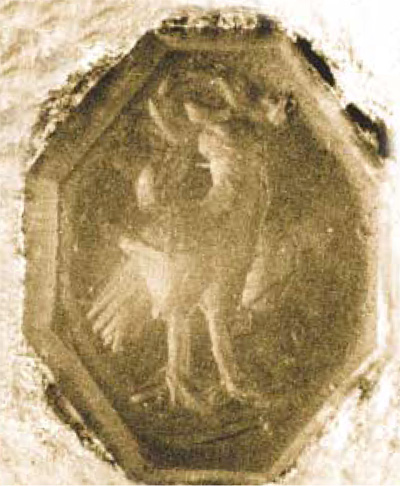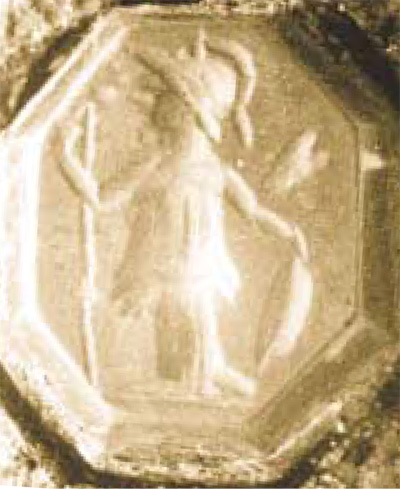
Fascination with collecting Roman gemstones is nothing new. In Roman times, Pompey the Great was an avid collector, as was the Emperor Hadrian. Private collection of these luxury items has continued unabated, and most museums now contain a varying quantity of carved semiprecious or glass gems, often donated or purchased during the 19th and early 20th centuries. The University Museum is no exception. It was endowed in 1904 with the Maxwell Sommerville Collection (cf. Expedition 41.1, 1999).
The importance of these collections in terms of scholarly research tends to be rather limited. The vast majority of the pieces are without definitive provenance, having been selected with an eye toward aesthetic or monetary — rather than archaeological — value. As a result, we know a great deal more about popular symbolic motifs and styles of carving than about the carvers themselves or the mechanics of gemstone production and distribution.
On those infrequent occasions when Roman gemstones are recovered within secure archaeological contexts, we have an invaluable opportunity to study gemstones not merely as beautiful objets d’art but as relevant cultural artifacts. One such occasion, previously overlooked, arose during the 1950s and early 1960s when members of the Museum team unearthed a dozen Roman-period rings amid the second- to fourth-century A.D.burials in the Common Cemetery at Gordion, Turkey (ca. Expedition 43.2, 2001). These rings were recovered in fair to excellent condition, with iron, bronze, silver, or gold bands surmounted by either glass paste or semiprecious stones bearing incised or engraved carvings (intaglios). These carvings depict a broad range of popular motifs of the period, from goddesses such as Fortuna/Tyche to more abstract symbols such as the dextrarum iunctio, a pair of clasped right hands often used to signify a matrimonial bond. The roughly incised quality of the intaglios reinforces a long, widely held belief that gems of the later Imperial period (second to fourth century A.D.) were generally of inferior craftsmanship compared with those of the preceding Hellenistic and early Imperial eras (third century B.C. to first century A.D.).


The most interesting feature of this small collection is three octagonal-cut gemstones: a carnelian intaglio bearing a depiction of Athena Promachos; an eagle grasping a wreath (a martial symbol); and a hand pinching an ear (a popular symbol for memory). While the thematic motifs and style of their carving are not unusual for the period, the octagonal shape of the gems is striking, a rare cut that appears in few published collections and not at all within standard discussions of gemstone typology. In those scattered catalogues where octagonal gems are listed, they are generally dated loosely, from the first to fourth centuries A.D., and are listed without a secure provenance. Despite their comparative rarity and the curiosity they evoke, signs of their production and dissemination remain elusive and obscure.
I identified the Gordion gemstones and now suggest a new solution to this puzzle, aided by the serendipitous publication of two books on eight new octagonal stones. The J. Paul Getty Museum collection described in Jeffery Spier’s Ancient Gems and Finger Rings contains three new octagonal gems, including one with a dextrarum iunctio carving (#394) nearly identical to that on the Gordion piece. Although lacking exact details, all are listed as having a provenance of Asia Minor, and one stone (#395) appears to be carved with a representation of the sacred Mount Argaios in Cappadocia, a popular representation on Roman coinage of that region. Additional octagonal gemstones appear in the new, beautiful illustrated Ancient Gems and Finger Rings from Asia Minor, the catalogue of the Yüksel Ermitan Collection by Koray Konuk and Melih Arslan. This trove represents the first major collection of Anatolian rings and gems ever published. While the precise provenance of the five octagonal gemstones it showcases remains uncertain, all the artifacts were unquestionably discovered in the boundaries of modern Turkey. The presence of so many of them in this collection reinforces the view that octagonal gemstones were popular in, if not produced in, Roman Anatolia.
It now seems possible to identify with some assurance the production center(s) and circulation area of this distinctive type of gemstone. The relative abundance of octagonal gems at Gordion (one quarter of the total recovered), in combination with the published stones from Turkey, suggests that one or more workshops existed in central Anatolia, perhaps in the metropolitan centers of Roman Galatia and/or Cappadocia. The intaglios, so rare among collections throughout the world, appear to represent a local style popular in that geographic area, one that, while failing to gain popularity elsewhere in the Roman Empire, appears to have flourished within the imperial Roman provinces of central Turkey.
Andrew L. Goldman is a research associate of the Mediterranean Section. During 2000–2001 he was the Rodney S. Young Postdoctoral Fellow at the University of Pennsylvania Museum. He received his Ph.D. in classical archaeology from the University of North Carolina, Chapel Hill, and has been a member of the Gordion Excavation Team since 1992. He is currently at work on a monograph on Roman Gordion, the first comprehensive study of a Roman-period town in central Turkeys.
